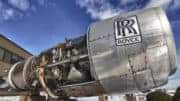Rolls Royce Aircraft Engine Manual
Rolls-Royce engines are some of the most advanced machines ever designed and built. We take pride in keeping our customers’ engines at the peak of operating efficiency and reliability. We recognise that different operators have different requirements throughout a product’s lifecycle and these can best be satisfied via a wide range of. The Rolls-Royce Merlin is a British liquid-cooled V-12 piston aero engine of 27-litres (1,650 cu in) capacity. Rolls-Royce designed the engine and first ran it in 1933 as a private venture. Initially known as the PV-12, it was later called Merlin following the company convention of naming its piston aero engines after birds of prey. After several modifications, the first production variants. The Rolls-Royce Meteor and later the Rover Meteor was a British tank engine developed during the Second World War. It was used in British tanks up to 1964. It was a result of co-operation between Leyland Motors and Rolls-Royce who between them in 1941 had suggested that a specialised de-rated version of the latter company's Merlin aero-engine would be highly suitable for use in armoured.
| During World War II, thousands of Rolls-Royce Merlin engines powered several famous aircraft such as the Supermarine Spitfire, Hawker Hurricane, DeHavilland Mosquito, P-51 Mustang, and the Avro Lancaster. The Merlin engine was developed in England in 1936, and was used in the prototype Spitfire F39/34. In 1939, a Rolls-Royce Merlin MK II engine, producing 1,030 hp, was selected to power the first production Spitfire. In early 1941, Packard Motors was licensed to build Merlin engines. The majority of Packard built Merlins were destined for what is considered by most to be the best fighter of World War II, the North American P-51 Mustang. The first Mustangs were powered by the Allison V-1710 engine, but by 1943, the Mustang P51B & C, (RAF Mustang III) were powered by a V-1650-3 Packard Merlin engine producing 1,520 hp. In Canada, the Packard Merlins were designated Merlin 28 and 29. Later models of the Curtiss P-40 were also powered by Packard Merlins. |



Rolls Royce Aircraft Engine Manuals Log In
| The standard engine for the P-51D Mustang was the liquid-cooled, l2-cylinder, Packard-built, Rolls-Royce Merlin V-1650-3 or -7 developing 1,400 hp at take-off. The original Mustangs were fitted with low-altitude rated Allison V-1710 engines, but as the possibilities of the Mustang as a high-altitude fighter was realized, it was decided to fit the aircraft with a Merlin engine. For this purpose, four Mustang Mark Is were sent to Rolls-Royce for use as development aircraft, AL963, AL975, AM203 and AM208. Merlin 61 series engines were installed with a frontal radiator, in addition to the normal ventral scoop. The Mustang/Rolls-Royce combination was an instant success and it was adopted as standard for all the Mustang variants. To increase engine production, Packard was selected to build the Merlin under license. |
| The Merlin was fitted with an injection-type carburetor and a two-stage supercharger. The carburetor however, was at a disadvantage in maintaining positive fuel flow during negative G maneuvers causing the engine to sputter or cut-out. Unlike the German Daimler-Benz DB 601 which uses fuel-injection, this system maintains positive fuel flow when pulling negative Gs. Fuel-injection allowed many a Messerschmitt Bf 109 pilot to escape a Spitfire on its tail and return to fight another day. The -3 engine supercharger cut-in at 19,000 feet, and the -7, between 14,500 and 19,000 feet. The supercharger was automatic, but could be manually over ridden. In order to give the engine an extra burst of power during an emergency, the throttle could be pushed past the gate stop by breaking the safety wire. If used longer than five minutes, there was a risk of severe engine damage. There was no doubt when the supercharger cut into the high-blower position on the P-51 Mustang. The aircraft shuddered violently and pilots had to learn to anticipate the cut-in and reduce throttle. When descending, the change to low-blower took place at about 14,500 feet, and the only indication of the event was a drop in manifold pressure. The Packard Merlin drove either a four-blade Hamilton-Standard Hydromatic or Aeroproducts automatic, constant-speed propeller. Coolant (30/70 ethylene-glycol/water) and oil radiators were installed in the pronounced belly scoop radiator fairing under the fuselage. One weakness of the Merlin was that it could be put out of action by a single bullet or shrapnel, but this applied to all liquid-cooled engines and did not detract from the Mustang's all-round capabilities. The Mustang was a welcome sight to the Boeing B-17 Fortress crews as they plunged deep into German skies during the daylight offensive against the Nazi armament industries. The Merlin went through continuous development throughout World War II, ending up with at MK 71. The Merlin series was then superseded by the Griffon series. |
| Specifications: | |
|---|---|
| Rolls-Royce Merlin I | |
| Date: | 1936 |
| Cylinders: | 12 |
| Configuration: | V, Liquid cooled |
| Horsepower: | 1,030 (768 kw) |
| RPM: | 3,000 |
| Bore and Stroke: | 5.4 in. (137 mm) x 6 in. (152 mm) |
| Displacement: | 1,650 cu. in. (27 liters) |
| Weight: | 1,320 lbs. (600 kg) |
Rolls Royce Aircraft Engine Manuals
Return To Engine Index. © The Aviation History On-Line Museum.All rights reserved.
Created November 29, 2006. Updated October 12, 2013.